story and photos by Jamie Rector
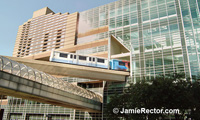 If you’re in downtown Detroit on business and find yourself with a little free time on a rainy or snowy day, your connection to anywhere you might want to be in the central business district is the Detroit People Mover. This light rail system that makes a loop through 13 stations is built high above traffic and provides excellent views of the city, its landmarks and the Detroit River. Since eight of the People Mover stations are inside buildings, you have access to over nine million square feet of retail shopping, entertainment venues, hotels, offices, civic center services and residential space without ever going outside.
If you’re in downtown Detroit on business and find yourself with a little free time on a rainy or snowy day, your connection to anywhere you might want to be in the central business district is the Detroit People Mover. This light rail system that makes a loop through 13 stations is built high above traffic and provides excellent views of the city, its landmarks and the Detroit River. Since eight of the People Mover stations are inside buildings, you have access to over nine million square feet of retail shopping, entertainment venues, hotels, offices, civic center services and residential space without ever going outside.
If You Have an Hour: The People Mover Art Tour
For fifty cents, this elevated, public metro system will take you on an informal fifteen minute tour of downtown as it winds its way around to come full circle. Each People Mover Station is decorated with public art works from tile murals to paintings and sculptures. Most are inside the stations, but two of the most popular are outside. At the Grand Circus Station, J. Seward Johnson, Jr.’s statue “Catching Up” is a man leaning against a pole outside the station reading a Detroit newspaper. Another popular installation that can be appreciated from inside and outside the station – but only at night – is the colorful abstract neon tubing that covers the windows and sides of the Greektown Station. Trains run every three or four minutes, so if you decide to get off to take a closer look, another train will be along soon.
If You Have Two Hours: The Ren Cen Tour
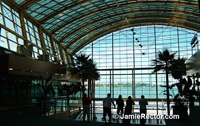 The People Mover stops at the Renaissance Center, Detroit’s most recognizable architectural landmark. Six high rise office towers surround the 73 story cylindrical Marriot Hotel at its center.The Ren Cen, as its known locally, has gone through its ups and downs since Henry Ford II and a group of local developers opened it in 1977. GM bought the complex in 2001 and did a complete makeover that got its final touches in 2005. The Ren Cen offers a one-hour tour four times a day, six days per week. The tour starts at the General Motors Wintergarden, a five-story glass atrium with two levels of local and international chain boutiques and restaurants. Other highlights
The People Mover stops at the Renaissance Center, Detroit’s most recognizable architectural landmark. Six high rise office towers surround the 73 story cylindrical Marriot Hotel at its center.The Ren Cen, as its known locally, has gone through its ups and downs since Henry Ford II and a group of local developers opened it in 1977. GM bought the complex in 2001 and did a complete makeover that got its final touches in 2005. The Ren Cen offers a one-hour tour four times a day, six days per week. The tour starts at the General Motors Wintergarden, a five-story glass atrium with two levels of local and international chain boutiques and restaurants. Other highlights 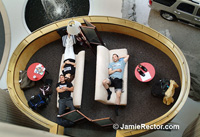 include GM World, a showcase for past, present and future GM cars; a tour of the movie theatre and an elevator ride up to the 72 nd floor to admire the view – 30 miles on a clear day.
include GM World, a showcase for past, present and future GM cars; a tour of the movie theatre and an elevator ride up to the 72 nd floor to admire the view – 30 miles on a clear day.
When you wander along the vast open corridors, make sure to look over the railing. You’ll likely see people resting, perhaps napping, in the seating pods below. If the weather’s not too bad, you can take a stroll through the GM Plaza and Promenade along the riverfront, accessible through the Wintergarden.
If You Have Three Hours: Diamond Jack’s River Tour
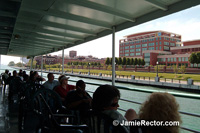 Also at the Renaissance Center stop, just off the Promenade on the Detroit River is theDiamond Jack’s River Tour dock. Diamond Jack’s offers two-hour narrated tours through the crystalline waters of the Detroit River. Visibility would be limited during a downpour, but if it’s just drizzling, there is covered seating and an inside cabin area with a view.
Also at the Renaissance Center stop, just off the Promenade on the Detroit River is theDiamond Jack’s River Tour dock. Diamond Jack’s offers two-hour narrated tours through the crystalline waters of the Detroit River. Visibility would be limited during a downpour, but if it’s just drizzling, there is covered seating and an inside cabin area with a view.
The ship cruises up along the wide, flowing water toward Lake St. Claire 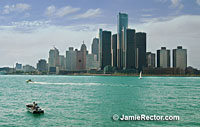 keeping company with Sailboats and barges making their own way along the mile-wide waterway. The tour passes the Mayor’s residence, the Manoogian Mansion, nestled along the shore. The vessel continues to meander under the MacArthur Bridge and around Belle Isle and back down on the Canadian side. Friendly Canadians wave to the ship as it floats past downtown Windsor and waterfront residences and eventually under the mighty Ambassador Bridge before it heads back along Hart Plaza and Joe Lewis Arena into downtown Detroit.
keeping company with Sailboats and barges making their own way along the mile-wide waterway. The tour passes the Mayor’s residence, the Manoogian Mansion, nestled along the shore. The vessel continues to meander under the MacArthur Bridge and around Belle Isle and back down on the Canadian side. Friendly Canadians wave to the ship as it floats past downtown Windsor and waterfront residences and eventually under the mighty Ambassador Bridge before it heads back along Hart Plaza and Joe Lewis Arena into downtown Detroit.
If You’re Hungry: Greektown
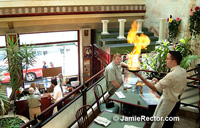 Greektown is the People Mover stop you want for great food and a cultural experience. The street is strung with flags and lined with restaurants, bakeries and shops all offering the look, feel and taste of walking through a street in Greece. The price range varies from a nice basic restaurant to an elegant eating experience. Make sure to check out the Saganaki at the multi-level New Parthenon Restaurant. The flaming cheese is always fun to watch and this establishment is reputed to be the inventor of this Detroit-Greek delicacy. “Opa!” Once your tummy is full from any of the more than 20 restaurants, bakeries or shops, you can empty your pockets at the Greektown Casino on the corner with free validated parking in their parking structure.
Greektown is the People Mover stop you want for great food and a cultural experience. The street is strung with flags and lined with restaurants, bakeries and shops all offering the look, feel and taste of walking through a street in Greece. The price range varies from a nice basic restaurant to an elegant eating experience. Make sure to check out the Saganaki at the multi-level New Parthenon Restaurant. The flaming cheese is always fun to watch and this establishment is reputed to be the inventor of this Detroit-Greek delicacy. “Opa!” Once your tummy is full from any of the more than 20 restaurants, bakeries or shops, you can empty your pockets at the Greektown Casino on the corner with free validated parking in their parking structure.
For a complete directory of attractions accessible from each People Mover station, take a look at the Detroit People Mover Station Guide

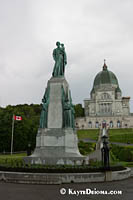 Montreal is a great city for exploring on your own and any of the venues in this issue would be perfectly appropriate to visit alone. But I somehow think of spiritual places as good solo destinations to take a quiet moment and ponder the universe. St. Joseph’s Oratory on Mount Royal is a nice spot for such pondering.
Montreal is a great city for exploring on your own and any of the venues in this issue would be perfectly appropriate to visit alone. But I somehow think of spiritual places as good solo destinations to take a quiet moment and ponder the universe. St. Joseph’s Oratory on Mount Royal is a nice spot for such pondering.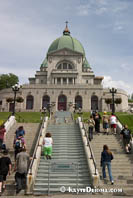 St. Joseph’s Oratory, at 856 feet (263 meters) above sea level, is the highest point in Montreal. From street level to the top of the dome is 506 feet (155 meters). That’s a lot of stairs to climb, especially if you are a pilgrim climbing the stairs on your knees. If you don’t feel like scaling the 233 steps up to the Crypt level, a shuttle will drive you from the gate house at street level up to the entrance.
St. Joseph’s Oratory, at 856 feet (263 meters) above sea level, is the highest point in Montreal. From street level to the top of the dome is 506 feet (155 meters). That’s a lot of stairs to climb, especially if you are a pilgrim climbing the stairs on your knees. If you don’t feel like scaling the 233 steps up to the Crypt level, a shuttle will drive you from the gate house at street level up to the entrance.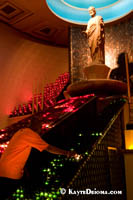 The Arrow Guide suggests entering the building from the side entrance into the Votive Chapel (marked with the number 1), a long corridor lined with votive altars. Each one is a tribute to St. Joseph in his various functions as model for workers, guardian of virgins, support of families, terror of demons, consolation of the afflicted, hope of the sick, patron of the dying, and protector of the Church. Halfway down the hall in the center lamp rack, 3,500 of the chapel’s 10,000 votive candles rise up to a statue of Joseph with arms outstretched. Between the altars, wooden crutches of those healed by Brother André are displayed hanging in rows. Notably, there are no aluminum crutches or other evidence of people being healed since the pious man’s passing.
The Arrow Guide suggests entering the building from the side entrance into the Votive Chapel (marked with the number 1), a long corridor lined with votive altars. Each one is a tribute to St. Joseph in his various functions as model for workers, guardian of virgins, support of families, terror of demons, consolation of the afflicted, hope of the sick, patron of the dying, and protector of the Church. Halfway down the hall in the center lamp rack, 3,500 of the chapel’s 10,000 votive candles rise up to a statue of Joseph with arms outstretched. Between the altars, wooden crutches of those healed by Brother André are displayed hanging in rows. Notably, there are no aluminum crutches or other evidence of people being healed since the pious man’s passing. To the left is the Crypt Church, so named for the flattened arches supporting the ceiling and its position at the foot of the Basilica. Rather than the traditional cross over the altar, a nine-foot statue of St. Joseph takes pride of place. The Christ statue on the large crucifix to the right of the altar has worn feet from the hands of many pilgrims. A giant statue of Brother André looms in front of the stained glass windows on the right wall. The colorful panels represent events in the life of St. Joseph.
To the left is the Crypt Church, so named for the flattened arches supporting the ceiling and its position at the foot of the Basilica. Rather than the traditional cross over the altar, a nine-foot statue of St. Joseph takes pride of place. The Christ statue on the large crucifix to the right of the altar has worn feet from the hands of many pilgrims. A giant statue of Brother André looms in front of the stained glass windows on the right wall. The colorful panels represent events in the life of St. Joseph.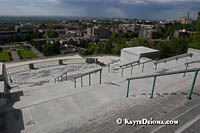 Doors at the back of the Crypt Church will take you to the escalators up to the Concourse Hall where you will find access to the terrace which provides a view of Montreal down the west side of Mount Royal. You’ll also find restrooms and drinking fountains on this floor and the stairway to theBrother André Display. You have to take the stairs, as the escalator bypasses this area. This exhibit contains recreations of the doorkeeper’s lodge at Notre Dame College, Brother André’s office and the hospital room where he died, some of them with original features. However the most important artifact in this display is the reliquary with Brother André’s heart.
Doors at the back of the Crypt Church will take you to the escalators up to the Concourse Hall where you will find access to the terrace which provides a view of Montreal down the west side of Mount Royal. You’ll also find restrooms and drinking fountains on this floor and the stairway to theBrother André Display. You have to take the stairs, as the escalator bypasses this area. This exhibit contains recreations of the doorkeeper’s lodge at Notre Dame College, Brother André’s office and the hospital room where he died, some of them with original features. However the most important artifact in this display is the reliquary with Brother André’s heart.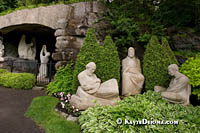 Back down on the Concourse level you can exit to the Way of the Crossand the Oratory Gardens. The larger-than-life Stations of the Cross lead through the gardens to the Pool and Fountain of Redemption. It’s a beautiful place to dwell and contemplate in nice weather, but if it’s raining significantly, you might want to proceed up the escalator to the OratoryMuseum.
Back down on the Concourse level you can exit to the Way of the Crossand the Oratory Gardens. The larger-than-life Stations of the Cross lead through the gardens to the Pool and Fountain of Redemption. It’s a beautiful place to dwell and contemplate in nice weather, but if it’s raining significantly, you might want to proceed up the escalator to the OratoryMuseum.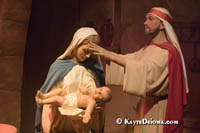 The front galleries are used for rotating exhibits from the Museum’s significant collection of artwork related to the Holy Family, St. Joseph and Brother André. Part of every year includes a Nativity Exhibit with 200 to 300 of the Museum’s thousands of crčches from around the world from the 6 th century through the present. Each annual exhibit includes at least 100 nativity scenes that have not been exhibited before. They range from miniatures to life size, from Indian needlework to Vietnamese Mother of Pearl, Sudanese ebony and incense paste from Singapore. The permanent exhibit at the back of the Museum is a series of wax figures behind glass portraying scenes from the life of St. Joseph.
The front galleries are used for rotating exhibits from the Museum’s significant collection of artwork related to the Holy Family, St. Joseph and Brother André. Part of every year includes a Nativity Exhibit with 200 to 300 of the Museum’s thousands of crčches from around the world from the 6 th century through the present. Each annual exhibit includes at least 100 nativity scenes that have not been exhibited before. They range from miniatures to life size, from Indian needlework to Vietnamese Mother of Pearl, Sudanese ebony and incense paste from Singapore. The permanent exhibit at the back of the Museum is a series of wax figures behind glass portraying scenes from the life of St. Joseph.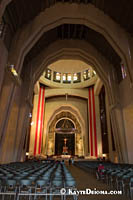 Above the museum is the Basilica. You can go back outside at this level to admire the 60 foot Corinthian columns close up and enjoy the view. This is the highest point you can climb if you’re ascending the 283 stars up the front of the Oratory. The interior dome rises 195 feet (60 m) above the floor. The cavernous space holds 2200 people seated in the metal folding chairs or 10,000 standing. It is rather stark in contrast to many basilicas in the world and less inviting than the cozy Crypt below. The dome is the third largest in the world after St. Peter’s in Rome and an African tribute to St. Peter’s, the Basilica of Our Lady of Peace in Ivory Coast. The stained glass windows depict some of the miraculous events in Canadian history attributed to the intervention of St. Joseph. The Grand Organ at the back of the Basilica has 5,811 pipes, with the longest 32 feet (9.75 m) tall. Organ recitals are every Sunday at 3:30 all year with a series of guest performances on Wednesday evenings in the summer.
Above the museum is the Basilica. You can go back outside at this level to admire the 60 foot Corinthian columns close up and enjoy the view. This is the highest point you can climb if you’re ascending the 283 stars up the front of the Oratory. The interior dome rises 195 feet (60 m) above the floor. The cavernous space holds 2200 people seated in the metal folding chairs or 10,000 standing. It is rather stark in contrast to many basilicas in the world and less inviting than the cozy Crypt below. The dome is the third largest in the world after St. Peter’s in Rome and an African tribute to St. Peter’s, the Basilica of Our Lady of Peace in Ivory Coast. The stained glass windows depict some of the miraculous events in Canadian history attributed to the intervention of St. Joseph. The Grand Organ at the back of the Basilica has 5,811 pipes, with the longest 32 feet (9.75 m) tall. Organ recitals are every Sunday at 3:30 all year with a series of guest performances on Wednesday evenings in the summer. Bangkok, whose full name translates as City of Angeles, Abode of the Emerald Buddah, is the home of approximately 28,000 temples, called wats in Thai. Exploring the wats is a great way to spend some time if you’re on your own. You can wander for hours, or even days exploring and meditating in these fascinating, spiritual places.
Bangkok, whose full name translates as City of Angeles, Abode of the Emerald Buddah, is the home of approximately 28,000 temples, called wats in Thai. Exploring the wats is a great way to spend some time if you’re on your own. You can wander for hours, or even days exploring and meditating in these fascinating, spiritual places. adorned with candles and incense. Many invite you to participate. Some ask for a donation.
adorned with candles and incense. Many invite you to participate. Some ask for a donation. The Grand Palace complex is one of the most extravagant wats in Bangkok. You can take a tour of the gardens as well as inside the palace. There are many rooms and parts of the palace grounds that will share the history of the royal and religious adventures of Bangkok and Thailand.
The Grand Palace complex is one of the most extravagant wats in Bangkok. You can take a tour of the gardens as well as inside the palace. There are many rooms and parts of the palace grounds that will share the history of the royal and religious adventures of Bangkok and Thailand. inch high, 18 inch wide Buddha carved of green jasper, the most revered Buddha image in Thailand. It was apparently found in Chiang Rai in the early 1400’s. It was moved several times in its lifetime before landing in Bangkok in 1778. The King himself changes the Buddha’s gilded garments three times a year to mark the change in the seasons: summer, rainy and winter.
inch high, 18 inch wide Buddha carved of green jasper, the most revered Buddha image in Thailand. It was apparently found in Chiang Rai in the early 1400’s. It was moved several times in its lifetime before landing in Bangkok in 1778. The King himself changes the Buddha’s gilded garments three times a year to mark the change in the seasons: summer, rainy and winter. appropriately; wats are religious places and respect for their traditions is expected. No shorts or short skirts. Women should have their shoulders covered when inside temples or holy places. Bring a light shawl that will fit easily in a bag and allow you to be appropriate instantly. In most temples you are required to take your shoes off, so watch out for your holey socks.
appropriately; wats are religious places and respect for their traditions is expected. No shorts or short skirts. Women should have their shoulders covered when inside temples or holy places. Bring a light shawl that will fit easily in a bag and allow you to be appropriate instantly. In most temples you are required to take your shoes off, so watch out for your holey socks.